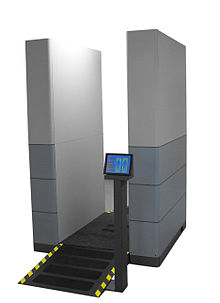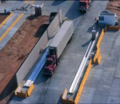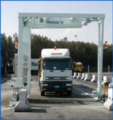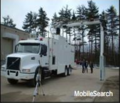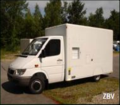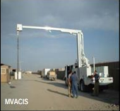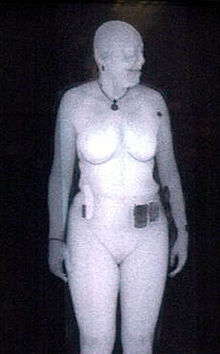- Backscatter X-ray
-
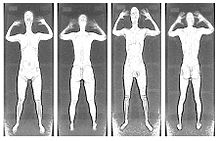 Backscatter technology produces an image that resembles a chalk etching.[1]
Backscatter technology produces an image that resembles a chalk etching.[1]
Backscatter X-ray is an advanced X-ray imaging technology. Traditional X-ray machines detect hard and soft materials by the variation in transmission through the target. In contrast, backscatter X-ray detects the radiation that reflects from the target. It has potential applications where less-destructive examination is required, and can be used if only one side of the target is available for examination.
The technology is one of two types of whole body imaging technologies being used to perform full-body scans of airline passengers to detect hidden weapons, tools, liquids, narcotics, currency, and other contraband. A competing technology is millimeter wave scanner. These airport security machines are also referred to as "body scanner", "whole body imager (WBI)", and "security scanner".
Contents
Technology
Backscatter technology is based on the X-ray compton scattering effect of X-rays, a form of ionizing radiation. Unlike a traditional X-ray machine which relies on the transmission of X-rays through the object, backscatter X-ray detects the radiation that reflects from the object and forms an image. The backscatter pattern is dependent on the material property, and is good for imaging organic material.
In contrast to millimeter wave scanners which create a 3D image, backscatter X-ray scanners will typically only create a 2D image. For airport screening, images are taken from both sides of the human body.[2]
Backscatter X-ray was first applied in a commercial low dose personnel scanning system by Dr. Steven W. Smith.[3][4][5] Dr. Smith developed the Secure 1000 whole body scanner in 1992 and then sold the device and associated patents to Rapiscan Systems who now manufactures and distributes the device.
The following companies manufacture commercial X-ray devices that are used in security scanning applications with price ranging from $500,000 to $2,000,000:
- American Science and Engineering[6] (device name: Smartcheck)
- Rapiscan Systems (a subsidiary of OSI Systems Inc.)[7][8] (device name: Secure 1000)
- Tek84 (formerly Spectrum San Diego Inc.)[9] (device name: AIT84 Body Scanner & Castscope)
Large scale
Some backscatter X-ray scanners can scan much larger objects, such as trucks and containers. This scan is much faster than a physical search, and could potentially allow a larger percentage of shipping to be checked for smuggled items, weapons, drugs, or people.[10]
The "Z Backscatter Van", or ZBV, from AS&E is a mobile backscatter X-ray machine in a van which "from the outside looks like an ordinary delivery van, allowing it to blend in to urban and other landscapes". It is being promoted as a means of examining the contents of vehicles, containers, and dumpsters. Like many of the truck-based scanners, it has an 'arm' that deploys from the van to be able to scan other vehicles passing through.[11]
Other companies in the industry are Smiths Detection and Rapiscan. [12]
There are also gamma-ray based systems coming to market, like the MVACIS. [13]
In May 2011, the Electronic Privacy Information Center filed suit against DHS under the Freedom of Information Act, claiming that DHS had withheld nearly 1000 pages of documents related to the Z backscatter vans and other mobile backscatter devices.[14]
Concerns
See also: Full body scanner#ControversiesPrivacy
Backscatter x-ray technology has been proposed as an alternative to personal searches at airport and other security checkpoints easily penetrating clothing to reveal concealed weapons. It raises privacy concerns about what is seen by the person viewing the scan. Some worry that viewing the image violates confidential medical information, such as the fact a passenger uses a colostomy bag, has a missing limb or wears a prosthesis, or is transsexual, despite the fact that the person viewing the image can't see the person they are screening.
The ACLU and the Electronic Privacy Information Center are opposed to this use of the technology, currently in use in the U.S. at 78 airports, four court houses, and two correctional facilities, with another 12 airports scheduled to receive them soon.[15] The ACLU refers to backscatter x-rays as a "virtual strip search".[16] In one Transportation Security Administration (TSA) trial, 79 percent of the public opted to try backscatter over the traditional pat-down in secondary screening.[17]
It is "possible for backscatter X-raying to produce photo-quality images of what's going on beneath our clothes", thus, many software implementations of the scan have been designed to distort private areas.[18] According to the TSA, further distortion is used in the Phoenix airport's trial system where photo-quality images are replaced by chalk outlines.[19][20] The TSA has also commented that screening procedures such as having the screener viewing the image located far away from the person being screened could be a possibility.[citation needed]
In light of this, some journalists have expressed concern that this blurring may allow people to carry weapons or certain explosives aboard by attaching the object or substance to their genitals.[18][21]
The British newspaper The Guardian has revealed concern among British officials that the use of such scanners to scan children may be illegal under the Protection of Children Act 1978, which prohibits the creation and distribution of indecent images of children. This concern may delay the introduction of routine backscatter scanning in UK airports, which had been planned in response to the attempted Christmas Day 2009 attack on Northwest Airlines Flight 253.[22]
The Fiqh Council of North America have also issued the following fatwa:
It is a violation of clear Islamic teachings that men or women be seen naked by other men and women. Islam highly emphasizes haya (modesty) and considers it part of faith. The Quran has commanded the believers, both men and women, to cover their private parts.[23]In August 2010, it was reported[24] that U.S. Marshals (part of the Department of Justice),[25] saved thousands of images from a low resolution MM wave scanner: This machine does not show details of human anatomy, and is a different kind of machine than the one used in airports. TSA, part of the Department of Homeland Security, reiterated that its scanners do not save images and that the scanners do not have the capability to save images when they are installed in airports.[26] In contrast, it is claimed that TSA officials admitted that the scanners are required to be capable of saving images for the purpose of evaluation, training and testing.[27][28]
TSA states that independent polling indicates that the U.S. public generally supports the deployment and use of body scanners at airports.[29]
Equal treatment of minorities
Current backscatter scanners installed by the TSA are unable to screen adequately for security threats inside turbans, hijab, burqas, casts, prosthetics and loose clothing.[30][31] This technology limitation of current scanners often requires these persons to undergo additional screening by hand or other methods and can cause additional delay or feelings of harassment.[32]
The next generation of backscatter scanners are able to screen these types of clothing.[33] The next generation of scanners can equalize the screening process for all persons so that religious majorities can travel through the imaging process as easily as other passengers.
Health effects
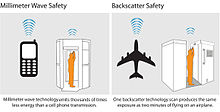 According to the TSA, "The energy projected by millimeter wave technology is thousands of times less than a cell phone transmission. A single scan using backscatter technology produces exposure equivalent to two minutes of flying on an airplane, but delivered in a few seconds."[34]
According to the TSA, "The energy projected by millimeter wave technology is thousands of times less than a cell phone transmission. A single scan using backscatter technology produces exposure equivalent to two minutes of flying on an airplane, but delivered in a few seconds."[34]
Unlike cell phone signals, or millimeter-wave scanners, he energy being emitted by a backscatter X-ray is a type of ionizing radiation that damages chemical bonds. Ionizing radiation is considered carcinogenic even in very small doses but at the doses used in airport scanners this effect is believed to be negligible for an individual.[35][36][37][38] If 1 million people were exposed to 520 scans in one year, one study estimated that roughly four additional cancers would occur due to the scanner, in contrast to the 600 additional cancers that would occur from the higher levels of radiation during flight.[39]
Since the scanners do not have a medical purpose, the United States Food and Drug Administration (FDA) does not need to subject them to the same safety evaluations as medical X-rays. [40] However, the FDA has created a webpage comparing known estimates of the radiation from backscatter X-ray body scanners to that of other known sources.[41] The web site states that:
To put the radiation dose received into perspective:
- Naturally occurring ionizing radiation is all around us. We are continuously exposed to this background radiation during ordinary living. In 42 minutes of ordinary living, a person receives more radiation from naturally occurring sources than from screening with any general-use x-ray security system.
- The national radiation safety standard (see below) sets a dose per screening limit for the general-use category. To meet the requirements of the general-use category a full-body x-ray security system must deliver less than the dose a person receives during four minutes of airline flight. TSA has set their dose limit to ensure a person receives less radiation from one scan with a TSA general-use x-ray security system than from two minutes of airline flight.
- A person would have to be screened more than a thousand times in one year to exceed the annual radiation dose limit for people screening that has been set by expert radiation safety organizations.
Four professors at the University of California, San Francisco, among them members of NAS and an expert in cancer and imaging, in a April 2010 letter[42] to the presidential science and technology advisor raised several concerns about the validity of the indirect comparisons the Food and Drug Administration used in evaluating the safety of backscatter x-ray machines.[43] They argued that the effective dose is higher than claimed by the TSA and the body scanner manufacturers because the dose was calculated as if distributed throughout the whole body whereas the most of the radiation is absorbed in the skin and tissues immediately underneath. Other professors from the radiology department at UCSF disagree with the claims of the signing four professors.[44]
The UCSF experts requested that additional data be made public detailing the specific data regarding sensitive areas such as the skin and certain organs, as well as data on the special (high risk) population. In October 2010, the FDA and TSA responded to these concerns.[45][46] The letter cites reports which show that the specific dose to the skin is some 89,000 times lower than the annual limit to the skin established by the NCRP. Regarding the UCSF concerns over the high risk population to sensitive organs, the letter states that such an individual "would have to receive more than 1000 screenings to begin to approach the annual limit".[47][48]
John Sedat, the principal author of the UCSF letter, responded in November 2010 that the White House's claim that full-body scanners pose no health risks to air travelers is in "error," adding that the White House statement has "many misconceptions, and we will write a careful answer pointing out their errors."[49]
In a December 2, 2010 letter to the House of Representatives, Dr. Steven Smith, inventor of the body scanner in 1991, has stated that the concerns of Dr. Brenner and UCSF regarding the skin dose of backscatter scanners is incorrect and the result of a confusion between dose and imaging penetration. Dr. Smith demonstrates this difference with two experiments using plastic (with a similar rate of absorption as body tissue), copper (the image subject), and an x-ray scanner. The dose penetration experiment shows that 5mm and 50mm plastic samples absorb 5% and 50% of the beam intensity respectively, whereas the imaging penetration experiment shows that 4.8mm and 10mm plastic samples reduce the image darkness by 23% and 50% respectively. Dr. Smith states that those who calculate high skin dosage have incorrectly used the shallow imaging penetration value of a few millimeters whereas the actual dosage is calculated by the deeper dose penetration.[50]
The TSA has also made public various independent safety assessments of the Secure 1000 Backscatter X-ray Scanner.[51][52][53][54]
Radiation safety authorities including the National Council on Radiation Protection and Measurements, The Health Physics Society and the American College of Radiology, have stated that there is no specific evidence that full-body scans are unsafe.[55] The Secure 1000 Backscatter X-ray scanner was developed in 1992 by Dr. Steve Smith.[5] The scanner has been studied extensively for almost 20 years by the leading independent radiation safety authorities in the United States.[55][56] Experimental and epidemiological data do not support the proposition, however, that there is a threshold dose of radiation below which there is no increased risk of cancer.[57]
The UK Health Protection Agency has completed an analysis of the X-ray dose from backscatter scanners and has written that the dose is extremely low and "about the same as people receive from background radiation in an hour".[58]
The Health Physics Society (HPS) reports that a person undergoing a backscatter scan receives approximately 0.05 μSv (or 0.005 mrems) of radiation; American Science and Engineering Inc. reports 0.09 μSv (0.009 mrems). At the high altitudes typical of commercial flights, naturally occurring cosmic radiation is considerably higher than at ground level. The radiation dose for a six hour flight is 20 μSv (2 mrems) — 200 to 400 times larger than a backscatter scan. According to U.S. regulatory agencies, "1 mrem per year is a negligible dose of radiation, and 25 mrem per year from a single source is the upper limit of safe radiation exposure".[18]
According to a draft standard on the United States FDA website, the allowable dose from a scan would be 0.1 μSv, and that report uses a model whereby a 0.01 μSv dose increases an individual's risk of death by cancer during his or her lifetime by 5×10−10.[59] Since the dose limit is ten times higher than 0.01 μSv, their model would predict one additional cancer death per 200 million scans. Since the airports in the UK handled 218 million passengers in 2009,[60] if all passengers in the UK were scanned at the maximum dosage, then each year this would produce on average one additional cancer death (since there would be 200 million scans per year that the scanners were in operation), though usually each death would not occur in the same year as the particular scan that caused it, since the cancer may take years to grow. In addition, additional people would be given cancer but would die from other causes.
There may not yet be evidence of hereditory effects of x-rays administered by backscatter scanners, but backscatter scanners use the same kind of x-ray photons as are produced in medical x-ray machines but expose the subject at a considerably lower dose, so it is possible that the results from medical radiology may be relevant, at least until a study is done of any effects specific to backscatter x-ray machines. Fathers exposed to medical diagnostic x-rays are more likely to have infants who contract leukemia, especially if exposure is closer to conception or includes two or more X-rays of the lower gastrointestinal (GI) tract or lower abdomen.[61] In medical radiography the x-ray beam is adjusted to expose only the area of which an image is required, so that generally shielding is applied to the patient to avoid exposing the gonads,[62] whereas in an airport backscatter scan, the testicles of men and boys will be deliberately subjected to the direct beam in order to check for weapons in the underpants, and some radiation will also reach the ovaries of female subjects. Double - strand breaks in DNA of human sperm has been studied at very high x-ray doses[63] in which they found a linear dose-response relationship at high doses. They did not study the effect at doses as low as would be used in x-ray airport scanners.
Extrapolations of cancer risk from minuscule exposures to radiation across large populations, however, are not supported by analysis by the National Council on Radiation Protection (NCRP). On May 26, 2010 NCRP issued a press release to address such comments about full body scanners that are compliant with ANSI N43.17. In Commentary No.16 issued on May 26, 2010, it reads as follows:
As stated in NCRP Report No. 121 (1995), Principles and Application of Collective Dose in Radiation Protection, the summation of trivial average risks over very large populations or time periods into a single value produces a distorted image of risk, completely out of perspective with risks accepted every day, both voluntarily and involuntarily.
According to NCRP, the use of statistical extrapolations that predict 1 death for every 200 million persons scanned for example (as above) is an unrealistic over-estimation.[64][65]
Other scientists at Columbia University have made the following statements in support of the safety of body scanners:[66]
"A passenger would need to be scanned using a backscatter scanner, from both the front and the back, about 200,000 times to receive the amount of radiation equal to one typical CT scan," said Dr. Andrew J. Einstein, director of cardiac CT research at Columbia University Medical Center in New York City. "Another way to look at this is that if you were scanned with a backscatter scanner every day of your life, you would still only receive a tenth of the dose of a typical CT scan," he said. By comparison, the amount of radiation from a backscatter scanner is equivalent to about 10 minutes of natural background radiation in the United States, Einstein said. "I believe that the general public has nothing to worry about in terms of the radiation from airline scanning," he added. For moms-to-be, no evidence supports an increased risk of miscarriage or fetal abnormalities from these scanners, Einstein added. "A pregnant woman will receive much more radiation from cosmic rays she is exposed to while flying than from passing through a scanner in the airport," he said.
Furthermore, other scientists claim the health effects of backscatter are well understood whereas those from millimeter wave scanners are not:
"From a radiation standpoint there has been no evidence that there is really any untoward effect from the use of this device [backscatter scanner], so I would not be concerned about it from a radiation dose standpoint – the issues of personal privacy are a different thing," he said. The health effects of the more common millimeter wave scanner are largely unknown, and at least one expert believes a safety study is warranted. "I am very interested in performing a National Council on Radiation Protection and Measurements study on the use of millimeter-wave security screening systems," said Thomas S. Tenforde, council president. However, no long-term studies have been done on the health effects of millimeter wave scanners.[66]
Experts evaluating backscatter x-ray machine technology have also argued that defects in the machines, damage from normal wear-and-tear, or software errors could focus an intense dose of radiation on just one spot of the body.[42] For example, Dr. Peter Rez, a professor of physics at Arizona State University, has said, "The thing that worries me the most, is not what happens if the machine works as advertised, but what happens if it doesn't," adding that a potential malfunction of the machine could increase the radiation dose.[67][68]
The designers and manufacturers of backscatter X-ray scanners claim that the scanners are designed to prevent the occurrence of these kinds of errors. The scanners' safety requirements include fail-safe controls and multiple overlapping interlocks. These features, combined with fault analysis, ensure that failure of any subsystem results in non-operation of the x-ray generator to prevent accidental exposures. In the United States, the TSA requires that certification to the ANSI N43.17 safety standard is performed by a third party and not by the manufacturer themselves.[69]
The European Commission issued a report stating that backscatter x-ray scanners pose no known health risk, and that "assuming all other conditions equal", that backscatter x-ray scanners, which expose people to ionizing radiation, should not be used when millimeter-wave scanners that "have less effects on the human body" are available.[70][71]
However, the European Commission report provides no data substantiating its claim that "all other conditions are equal". One area where backscatter X-ray scanners can provide better performance than MM wave scanners, for example, is in the inspection of the shoes, groin and armpit regions of the body.[72]
In a study published in the Archives of Internal Medicine on March 28, 2011 researchers at the University of California "calculated that fully implementing backscatter scanners would not significantly increase the lifetime risk of cancer for travelers."[73] [74] The researchers calculated that for every 100 million passengers who flew seven one-way flights, there would be one additional cancer.[75][76]
In May 2011 several scientists, including Agard, Sedat, Shuman, and Stroud from UCSF, complained that TSA's testing of the scanners was inadequate, and that its safety research report was heavily redacted and based on a model of a scanner, not on an actual scanner. Peter Rez, of Arizona State, also worried about mechanical failures that could lead to overdoses. [77]
Justifications for use
Since their health risks were understood, X-rays had previously not been used on humans for non-medical purposes.[40] However, some justify the additional individual risk from exposure to backscatter radiation, by citing benefit to the community as a whole.[78] For instance, if scans are carried out in the interest of public safety then the potential benefit of discovering a weapon on a person could be to the benefit of the community but not to the person being scanned. In other words, a person may be certain they are not carrying a weapon and may gain little by being scanned but the act of undergoing a scan may benefit other passengers.
Safety regulations and standards
In the US, manufacturers of security related equipment can apply for protection under the SAFETY act, which limits their financial liability in product liability cases to the amount of their insurance coverage. The Rapiscan Secure 1000 was listed in 2006.[79]
In the US, an X-ray system can be considered to comply with requirements for general purpose security screening of humans if the device complies with American National Standards Institute (ANSI) Standard #N43.17.[80][81]
In the most general sense, N43.17 states that a device can be used for general purpose security screening of humans if the dose to the subject is less than 25 μrems (0.25 μSv) per examination and complies with other requirements of the standard. Twenty-five micro Rem is equal to the amount of background radiation every human is exposed to (from the air and soil) at sea level every 1.5 hours and is also equal to the radiation exposure from cosmic rays when travelling in an airplane at altitude for 2 minutes.[82]
Many types of X-ray systems can be designed to comply with ANSI N43.17 including transmission X-ray,[83] backscatter X-ray and gamma ray systems. Not all backscatter X-ray devices necessarily comply with ANSI N43.17; only the manufacturer or end user can confirm compliance of a particular product to the standard.
ANSI standards use a standard of measurement algorithm called "effective dose" that considers the different exposure of all parts of the body and then weights them differently. The interior of the human body is given more weight in this survey and the exterior including the skin organ are given less weight. The Rapiscan backscatter machine produces an X-ray more absorbed by the skin than most other X-ray devices but is still regulated under the ANSI. The standard for "effective dose" damage done to the skin by X-rays is similar to the damage done by sunlight. [3]
The European Union is currently considering whether it is acceptable for this technology to be deployed in European Union airports. A report is pending from the Transport Committee of the European Parliament.
Technical countermeasures
Some people wish to prevent either the loss of privacy or the possibility of health problems or genetic damage that might be associated with being subjected to a backscatter X-ray scan. One company sells X-ray absorbing underwear which is said to have X-ray absorption equivalent to 0.5 mm of lead.[84] Another product, Flying Pasties, "are designed to obscure the most private parts of the human body when entering full body airport scanners", but their description does not seem to claim any protection from the X-ray beam penetrating the body of the person being scanned.[85]
See also
- Visible Intermodal Prevention and Response team
- Explosives trace-detection portal machine (puffer machine)
- Future Attribute Screening Technology
- Millimeter wave scanner
- Full body scanner
References
- ^ TSA: How it Works
- ^ "Imaging Technology". Transportation Security Administration. http://www.tsa.gov/approach/tech/imaging_technology.shtm. Retrieved December 31, 2009.
- ^ US patent 5181234, Steven W. Smith, "X-ray Backscatter Detection System", issued 1993-01-19
- ^ "Steven W. Smith / Original Developer of Secure 1000 in 1992". Tek84.com. http://www.tek84.com/company.html. Retrieved August 16, 2010.
- ^ a b Hamilton, Jon (January 14, 2010). "New Airport Body Scans Don't Detect All Weapons". NPR. http://www.npr.org/templates/story/story.php?storyId=122499686. Retrieved November 12, 2010.
- ^ AS&E website as-e.com
- ^ US patent 7826589, "Security System for Screening People", issued 2008-12-24
- ^ Rapiscan website rapiscansystems.com
- ^ Tek84 website tek84.com
- ^ "AS&E inspection products and solutions". As-e.com. http://www.as-e.com/products_solutions/index.asp. Retrieved August 16, 2010.
- ^ "AS&E Z Backsctter Van Promotional Video". http://www.youtube.com/watch?v=iABPKd0vFxQ.
- ^ GAO.gov, Feb 9 2011
- ^ NII Non-Intrusive Inspection, JPE-CBD, US Army Project Manager - Force Protection Systems, IED Threat Detection, pdf from osd.mil, Aug 2008. Retr May 2011.
- ^ Mobile Body Scanner Complaint, Electronic Privacy Information Center, retr May 28 2011
- ^ "TSA: Frequently Asked Questions". TSA.gov. http://www.tsa.gov/approach/tech/ait/faqs.shtm. Retrieved October 17, 2010.
- ^ "ACLU Backgrounder on Body Scanners and "Virtual Strip Searches"". aclu.org. January 8, 2010. http://www.aclu.org/technology-and-liberty/aclu-backgrounder-body-scanners-and-virtual-strip-searches.
- ^ "TSA: TSA Tests Second Passenger Imaging Technology at Phoenix Sky Harbor Airport". Tsa.gov. October 11, 2007. http://www.tsa.gov/press/releases/2007/press_release_10112007.shtm. Retrieved August 16, 2010.
- ^ a b c Layton, Julia. "Do 'Backscatter' X-Ray Systems Pose a Risk to Frequent Fliers?" HowStuffWorks. 27 February 2007. 18 March 2007.<http://travel.howstuffworks.com/backscatter.htm> "Backscatter" X-Ray Screening Technology". HowStuffWorks.
- ^ TSA privacy FAQ
- ^ Salatan, William. "Digital Penetration". Slate. http://www.slate.com/id/2160977/.
- ^ Electronic Privacy Information Center. 18 Mar. 2007 http://www.epic.org/privacy/airtravel/backscatter
- ^ Travis, Alan (January 4, 2009). "New scanners break child porn laws". The Guardian (London). http://www.guardian.co.uk/politics/2010/jan/04/new-scanners-child-porn-laws. Retrieved January 6, 2010.
- ^ "'Fatwa' forbids Muslims going through full-body scanners". Content.usatoday.com. February 12, 2010. http://content.usatoday.com/communities/ondeadline/post/2010/02/fatwa-forbids-muslims-going-through-full-body-scanners/1. Retrieved August 16, 2010.
- ^ "'Peep Show Database of American Travelers' — Video — FoxNews.com". Video.foxnews.com. http://video.foxnews.com/v/4303191/peep-show-database-of-american-travelers/?playlist_id=86919. Retrieved August 16, 2010.
- ^ Lundin, Leigh (August 15, 2010). "You show me yours and …". Florida News. Orlando: Criminal Brief. http://www.criminalbrief.com/?p=13511. "Remember Homeland Security told the public the scanners aren’t capable of storing images? Someone forgot to tell the scanner at the federal courthouse in Orlando…"
- ^ "The TSA Blog: TSA Response to "Feds admit storing checkpoint body scan images"". Blog.tsa.gov. June 8, 2010. http://blog.tsa.gov/2010/08/tsa-response-to-feds-admit-storing.html. Retrieved August 16, 2010.
- ^ Quinn, Rob (August 6, 2010). "Feds Admit Storing Body Scans". Newser.com. http://www.newser.com/story/97427/feds-admit-storing-body-scans.html. Retrieved November 20, 2010.
- ^ Shahid, Aliyah (August 4, 2010). "Feds admit they stored body scanner images, despite TSA claim the images cannot be saved". NYDailyNews.com. http://www.nydailynews.com/news/national/2010/08/04/2010-08-04_feds_admit_they_stored_body_scanner_images_despite_tsa_claim_the_images_cannot_b.html. Retrieved November 20, 2010.
- ^ "TSA: More Information". Tsa.gov. http://www.tsa.gov/approach/tech/ait/reading.shtm. Retrieved August 16, 2010.
- ^ Joseph Orovic. "Sikhs Cautioned Over ‘Random’ Air Searches". Queens Tribune. http://www.queenstribune.com/deadline/Deadline_012011_SikhsCautioned.html.
- ^ "Sikh outrage at US airport security". Al Jazeera. http://english.aljazeera.net/news/americas/2007/08/2008525141141752646.html.
- ^ http://www.cairchicago.org/2010/11/22/travel-advisory-know-your-rights-if-asked-to-undergo-new-tsa-enhanced-pat-downs
- ^ http://www.tek84.com/bodyscanner.html
- ^ TSA: Safety Advanced Imaging Technology
- ^ Leon Mullenders, Mike Atkinson, Herwig Paretzke, Laure Sabatier, Simon Bouffler (2009). "Assessing cancer risks of low-dose radiation". Nature Reviews Cancer 9 (8): 596–604. doi:10.1038/nrc2677. PMID 19629073.
- ^ Health Physics Society, 2004. Radiation Risk in Perspective PS010-2 [1] Below 5–10 rem (which includes occupational and environmental exposures), risks of health effects are either too small to be observed or are nonexistent.
- ^ The American Nuclear Society, 2001. Health Effects of Low-Level Radiation. Position Statement 41 [2]
- ^ 25 November 2010. "Society News Archive: BEIR VII Report Supports LNT Model". Hps.org. http://hps.org/newsandevents/newsarchive/oldnews497.html. Retrieved November 25, 2010.
- ^ Mehta, P; Smith-Bindman, R (2011 Mar 28). "Airport Full-Body Screening: What Is the Risk?". Archives of internal medicine. doi:10.1001/archinternmed.2011.105. PMID 21444831.
- ^ a b "U.S. Government Glossed Over Cancer Concerns As It Rolled Out Airport X-Ray Scanners". propublica.org. November 1, 2011. http://www.propublica.org/article/u.s.-government-glossed-over-cancer-concerns-as-it-rolled-out-airport-x-ray. Retrieved November 18,2011.
- ^ "Products for Security Screening of People". Fda.gov. http://www.fda.gov/Radiation-EmittingProducts/RadiationEmittingProductsandProcedures/SecuritySystems/ucm227201.htm. Retrieved November 25, 2010.
- ^ a b John Sedat, et. al. (April 6, 2010). "Letter of Concern". pp. 4. http://www.npr.org/assets/news/2010/05/17/concern.pdf. Retrieved November 26, 2010.
- ^ "Scientists Question Safety Of New Airport Scanners". NPR. http://www.npr.org/templates/story/story.php?storyId=126833083. Retrieved November 7, 2010.
- ^ Lauren Smiley. "TSA Scanners: U.C. San Francisco Radiologists Debunk Radiation Fears". SFWeekly. http://blogs.sfweekly.com/thesnitch/2010/11/tsa_scanner_controversy_ucsf_r.php.
- ^ Holdren, John P.. "Response to University of California — San Francisco Regarding Their Letter of Concern, October 12, 2010". Office of Science and Technology Policy. http://www.fda.gov/Radiation-EmittingProducts/RadiationEmittingProductsandProcedures/SecuritySystems/ucm231857.htm. Retrieved November 12, 2010.
- ^ Larson, Phil. "Backscatter Back-Story". Office of Science and Technology Policy. http://www.whitehouse.gov/blog/2010/11/08/backscatter-back-story. Retrieved November 12, 2010.
- ^ FDA & NIST Assessment (2006); Our dose modeling reveals that a screening that delivers 0.25 µSv effective dose would deliver approximately 0.12 µSv to the uterus or 0.69 µSv to the testes.
- ^ NCRP Statement 10, Recent Applications of the NCRP Public Dose Limit Recommendation for Ionizing Radiation (2004) and NCRP report no. 116 Limitation of exposure to ionizing radiation
- ^ McCullagh, Declan. "Biochemist says 'naked' X-ray scanner may be unsafe | Privacy Inc. – CNET News". News.cnet.com. http://news.cnet.com/8301-31921_3-20022541-281.html#ixzz155dhfUQO. Retrieved November 25, 2010.
- ^ Smith, Steven. "Re: Misinformation on airport body scanner radiation safety". News.cnet.com. http://www.tek84.com/downloads/Holt-Letter2010-12-2.pdf. Retrieved December 03, 2010.
- ^ "TSA Memo". TSA. http://www.tsa.gov/assets/pdf/tsa_safety_study_ait_info_memo.pdf. Retrieved November 12, 2010.
- ^ "Radiation Engineering Assessment Report". Johns Hopkins University. http://www.tsa.gov/assets/pdf/jh_apl_v1.pdf. Retrieved November 12, 2010.
- ^ "Radiation Safety Engineering Assessment Report". Johns Hopkins University. http://www.tsa.gov/assets/pdf/jh_apl_v2.pdf. Retrieved November 12, 2010.
- ^ Cerra, Frank. "Assessment of the Rapiscan Secure 1000 Bodyscanner for Conformance with Radiological Safety Standards". NIST.
- ^ a b The TSA Blog: Advanced Imaging Technology: "Radiation Risk Tiny". Blog.tsa.gov. Retrieved on 2010-09-26.
- ^ http://www.tsa.gov/assets/pdf/ait_fact_sheet.pdf
- ^ Upton, AC (2003). "The state of the art in the 1990s: NCRP report No. 136 on the scientific bases for linearity in the dose-response relationship for ionizing radiation". Health Physics 85: 15–22. doi:10.1097/00004032-200307000-00005. PMID 12852466.
- ^ "Body scanning at airports". HPA. http://www.hpa.org.uk/Topics/Radiation/UnderstandingRadiation/UnderstandingRadiationTopics/BodyScanners/. Retrieved November 25, 2010.
- ^ "Draft Standard for Personnel Screening Systems". http://www.fda.gov/OHRMS/DOCKETS/AC/01/briefing/3751b1_06b.pdf.
- ^ "Size of Reporting Airports December 2008 — November 2009". http://www.caa.co.uk/docs/80/airport_data/200911/Table_01_Size_of_UK_Airports.pdf.
- ^ Xiao-Ou, Shu; et al (December 1994). "Association of paternal diagnostic X-ray exposure with risk of infant leukemia". Cancer Epidemiology, Biomarkers & Prevention (American Association for Cancer Research) 3 (8): 645. ISSN 1538-7755. PMID 7881337. http://www.ncbi.nlm.nih.gov/pubmed/7881337.
- ^ The Gonad Shield in Pelvic X-Rays: Covering a Multitude of Sins?, Booth Hall Children’s Hospital, Central Manchester and Manchester Children’s University Hospitals NHS Trust, Manchester, U.K.
- ^ Narendra P. Singh1,3 and Ralph E.Stephens2. "X-ray-induced DNA double-strand breaks in human sperm — Mutagenesis". Mutage.oxfordjournals.org. http://mutage.oxfordjournals.org/content/13/1/75.abstract. Retrieved November 25, 2010.
- ^ "Commentary No. 16 — Screening of Humans for Security Purposes Using Ionizing Radiation Scanning Systems". National Council on Radiation Protection & Measurements. http://www.ncrppublications.org/Commentaries/16. Retrieved November 12, 2010.(subscription required)
- ^ "Structural Shielding Design and Evaluation for Megavoltage Radiotherapy Facilities" (PDF). http://www.ncrponline.org/Press_Rel/Commentaries/Comm_16_Press_Release.pdf. Retrieved August 16, 2010.
- ^ a b Airport Full Body Scanners Pose No Health Threat: Experts. BusinessWeek (2010-01-08). Retrieved on 2010-09-26.
- ^ "Airport body-scan radiation under scrutiny". CNN. http://www.cnn.com/2010/TRAVEL/11/12/body.scanning.radiation/index.html?hpt=T2.
- ^ Peter Rez; Robert I. Metzger, Kenneth L. Mossman (November 2010). "The Dose From Compton Backscatter Screening". Oxford Journals: Radiation Protection Dosimetry. http://rpd.oxfordjournals.org/content/early/2010/11/09/rpd.ncq358.abstract. Retrieved November 26, 2010.
- ^ ANSI N43.17 (2009) sections 7.2.1 and 7.2.2
- ^ "Microsoft Word — Ethics Of Body Scanner Policy Report" (PDF). http://www.riseproject.eu/_fileupload/ETHICS%20OF%20BODY%20SCANNER%20POLICY%20REPORT%20NEW.pdf. Retrieved August 16, 2010.
- ^ See bullet 3 on page 6 of 47 in EU Ethics of Body Scanner Policy Report
- ^ Tek84. Tek84 (2010-03-17). Retrieved on 2010-09-26.
- ^ Mehta, P.; Smith-Bindman, R. (2011). "Airport Full-Body Screening: What Is the Risk?". Archives of Internal Medicine. doi:10.1001/archinternmed.2011.105. ISSN 0003-9926. PMID 21444831.
- ^ Bardi, Jason (March 28, 2011). "Analysis Suggests Cancer Risk of Backscatter Airport Scanners is Low". UCSF. http://www.ucsf.edu/news/2011/03/9619/analysis-suggests-cancer-risk-backscatter-airport-scanners-low. Retrieved 2011-03-31.
- ^ "Cancer risk is low, but possible in airport scanners". CNN. March 28th, 2011. http://thechart.blogs.cnn.com/2011/03/28/cancer-risk-is-low-but-possible-in-airport-scanners/. Retrieved 2011-03-31.
- ^ Cohen, Elizabeth (March 31, 2011). "Airport security scans: What would your doctor do?". CNN. http://edition.cnn.com/2011/HEALTH/03/31/ep.airport.scanners/. Retrieved 2011-03-31.
- ^ Scientists Cast Doubt on TSA Tests of Full-Body Scanners, by Michael Grabell, ProPublica, May 16, 2011, retr May 28 2011
- ^ "Risk benefit analysis in medical radiography". http://www.hpa.org.uk/Topics/Radiation/UnderstandingRadiation/FrequentlyAskedQuestions/MedicalRadiation/#3.
- ^ "US government SAFETY act website". https://www.safetyact.gov/.
- ^ 16 August 2010 (January 15, 2010). "Health Physics Society 1". Hps.org. http://www.hps.org/hpssc/N43Status.html. Retrieved August 16, 2010.
- ^ "Health Physics Society 2". Hpschapters.org. August 9, 2007. http://hpschapters.org/2009AM/program/singlesession.php3?sessid=WPM-D. Retrieved August 16, 2010.
- ^ "US Environmental Protection Agency Radiation Dose Calculator". Epa.gov. June 28, 2006. http://www.epa.gov/rpdweb00/understand/calculate.html. Retrieved August 16, 2010.
- ^ "Products: X-ray passenger vehicle inspection VACIS XPL". SAIC. http://www.saic.com/products/security/vacis-xpl/. Retrieved August 16, 2010.
- ^ "Rocky Flats Gear X-ray protection". http://rockyflatsgear.com/.
- ^ "Flying Pasties". http://www.flyingpasties.com/.
External links
- Z-Backscatter Van — video of a backscatter x-ray, mounted on surveillance trucks.
- Full-body scans of fliers set off debate over privacy, health
- University of Florida Research — High Resolution Scatter X-ray Imaging
- Rapiscan Systems
- Backscatter X-ray technology and risks
Categories:- Aviation security
- Radiography
- Explosives detection
Wikimedia Foundation. 2010.

